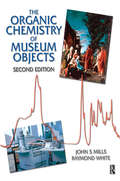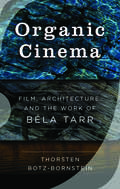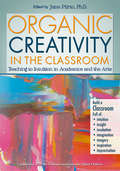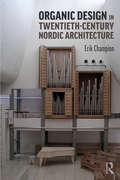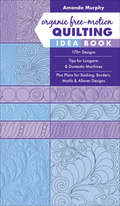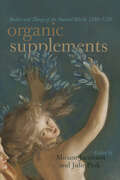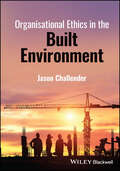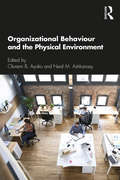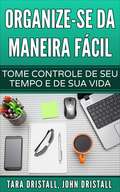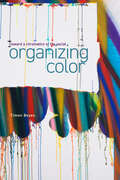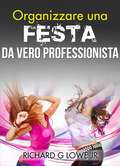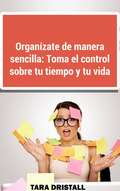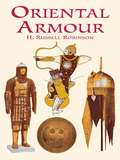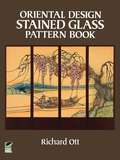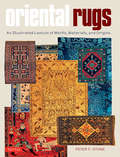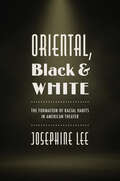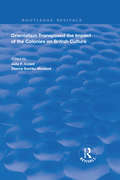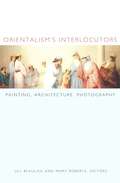- Table View
- List View
Organic Chemistry of Museum Objects
by John Mills Raymond White'The Organic Chemistry of Museum Objects' makes available in a single volume, a survey of the chemical composition, properties and analysis of the whole range of organic materials incorporated into objects and artworks found in museum collections. The authors cover the fundamental chemistry of the bulk materials such as wood, paper, natural fibres and skin products, as well as that of the relatively minor components incorporated as paint, media, varnishes, adhesives and dyes. This expanded second edition, now in paperback, follows the structure of the first, though it has been extensively updated. In addition to chapters on basic organic chemistry, analytical methods, analytical findings and fundamental aspects of deterioration, the subject matter is grouped as far as possible by broad chemical class - oils and fats, waxes, bitumens, carbohydrates, proteins, natural resins, dyestuffs and synthetic polymers. This is an essential purchase for all practising and student conservators, restorers, museum scientists, curators and organic chemists.
Organic Cinema: Film, Architecture, and the Work of Béla Tarr
by Thorsten Botz-BornsteinThe “organic” is by now a venerable concept within aesthetics, architecture, and art history, but what might such a term mean within the spatialities and temporalities of film? By way of an answer, this concise and innovative study locates organicity in the work of Béla Tarr, the renowned Hungarian filmmaker and pioneer of the “slow cinema” movement. Through a wholly original analysis of the long take and other signature features of Tarr’s work, author Thorsten Botz-Bornstein establishes compelling links between the seemingly remote spheres of film and architecture, revealing shared organic principles that emphasize the transcendence of boundaries.
Organic Crafts: 75 Earth-Friendly Art Activities
by Kimberly MonaghanParents, teachers, and caregivers looking for ideas on how to get children outdoors and instill in them a love of nature can find more than 75 creative crafts, games, and activities using objects that kids can collect from nature in this idea book. As children make race cars out of rocks, create paint from plants, and assemble funny grass masks, they learn to be environmentally friendly--absorbing information on recycling, reducing waste, and inspiring others to protect nature. Organized by the various natural materials needed, the crafts offer a new twist on perennial homemade gifts and school projects.
Organic Creativity in the Classroom: Teaching to Intuition in Academics and the Arts
by Jane PiirtoOrganic Creativity in the Classroom demonstrates an approach to teaching creatively-teaching to intuition-that is written by experienced, award-winning classroom teachers. Instead of focusing on divergent production skills such as fluency and flexibility, an outdated approach that dominates the field of creativity studies, this book includes helpful strategies that can be used to encourage students to become more creative within a specific domain. Teachers of writing, mathematics, science, social science, literature, foreign language, theater, songwriting, psychology, comparative religion, and arts education, among other domains, who infuse creativity and intuition into their classrooms share their practical advice using an insightful storytelling approach.
Organic Design in Twentieth-Century Nordic Architecture
by Erik ChampionOrganic Design in Twentieth-Century Nordic Architecture presents a communicable and useful definition of organic architecture that reaches beyond constraints. The book focuses on the works and writings of architects in Nordic countries, such as Sigurd Lewerentz, Jørn Utzon, Sverre Fehn and the Aaltos (Aino, Elissa and Alvar), among others. It is structured around the ideas of organic design principles that influenced them and allowed their work to evolve from one building to another. Erik Champion argues organic architecture can be viewed as a concerted attempt to thematically unify the built environment through the allegorical expression of ongoing interaction between designer, architectural brief and building-as-process. With over 140 black and white images, this book is an intriguing read for architecture students and professionals alike.
Organic Free-Motion Quilting Idea Book
by Amanda MurphyLet Mother Nature inspire your quilting with this guide full of inspiring ideas, techniques, and tips from the acclaimed fabric and quilt designer.Following the success of her Free-Motion Quilting Idea Book and Rulerwork Quilting Idea Book, Amanda Murphy shares an all-new volume packed with exciting designs. This handy guide provides more than one hundred original ideas inspired by the elements around you—water, air, feathers, ferns, leaves, sticks, stones, flowers, and fire. Amanda’s step-by-step instructions will help you gain confidence in your free-motion work. Then she offers a myriad of ideas organized by element and design type for you to you branch out and get creative. With Organic Free-Motion Quilting Idea Book, you can add texture, movement, and a sense of the natural world to your quilting, whether you're sewing on a domestic sewing machine or a longarm.
Organic Supplements: Bodies and Things of the Natural World, 1580–1790
by Jessica Wolfe Julia Reinhard Lupton Rebecca Laroche Kevin Lambert Michael Yonan Diane Purkiss Professor Lynn Festa Professor Jayne Elizabeth LewisFrom the hair of a famous dead poet to botanical ornaments and meat pies, the subjects of this book are dynamic, organic artifacts. A cross-disciplinary collection of essays, Organic Supplements examines the interlaced relationships between natural things and human beings in early modern and eighteenth-century Europe. The material qualities of things as living organisms—and things that originate from living organisms— enabled a range of critical actions and experiences to take place for the people who wore, used, consumed, or perceived them.
Organisational Ethics in the Built Environment
by Jason ChallenderOrganisational Ethics in the Built Environment A comprehensive analysis of the critical role played by ethics in construction organisations, and a toolkit for implementing a strong ethical culture In Organisational Ethics in the Built Environment, accomplished construction leader Jason Challender delivers an insightful and important resource for construction industry professionals contributing to the creation of safe and suitable projects. The author explains how to construct the foundation for ethical building and business practices in the construction industry, and explores the methods, motives and rationales behind successful and ethical projects from an organisational and industry perspective. You’ll learn how practical improvements to organisational ethics can promote ethical standards, behaviours and practices and influence the success of projects in the built environment. You’ll also discover the importance of leadership, motivational management, human resource management, corporate responsibility and social value in encouraging strict compliance and adherence to ethical principles, values and standards within organisations. Readers will also find: A thorough introduction to the critical importance of trust, collaborative working and partnering arrangements in contemporary construction and engineering organisations Comprehensive explorations of the relevance of environmental ethics Practical discussions of how to link corporate policies and strategies to ethical guidelines Case studies from across a variety of knowledge fields, including manufacturing and retail Perfect for construction managers, Organisational Ethics in the Built Environment will also benefit undergraduate and postgraduate students of construction, business, management, engineering and other construction related subjects.
Organizational Behaviour and the Physical Environment
by Neal M. Ashkanasy Oluremi B. AyokoThis book looks at how the physical environment of work shapes organizational behaviour, demonstrating that our physical surroundings at work can have a big influence on employee productivity, performance and wellbeing. Drawing upon the latest research, Organizational Behaviour and the Physical Environment provides comprehensive coverage of the different aspects of the physical environment at work – the buildings, furnishings, equipment, lighting, air quality and their configurations. From theories of psychological ownership and work design, to cultural issues and technology in the workplace, its international range of contributors provide voices from Australasia, North America, Europe and the Middle East. This book will be invaluable supplementary reading for advanced students, researchers and practitioners across the fields of organizational behaviour, HRM, organizational and environmental psychology, and workspace design.
Organize-se da maneira fácil: Tome controle de seu tempo e de sua vida
by John Dristall Tara Dristall DereckEste livro te ajuda a se organizar através da simplicidade. Você não precisa de um sistema de gestão de tempo complicado, ou um planejador cheio com cada tarefa descrita até o último detalhe. Você precisa de um sistema básico que dê conta do recado sem se tornar um projeto em si. Os autores dão conselhos práticos para se organizar em todos os aspectos de sua vida: • Organizando sua mesa e papelada • Controlando seu computador e smartphone ao invés de ser controlado por eles • Controlando suas finanças • Dicas rápidas para organizar sua casa • Controle e planejamento de tempo • Organizando-se como uma família Os autores incluem um questionário simples no começo de cada capítulo para que você possa acompanhar onde você está e onde precisa melhorar. Este livro vai te ajudar a tomar conta dos detalhes, livrar-se da pressão da sobrecarga e encontrar mais satisfação em sua vida.
Organizing Color: Toward a Chromatics of the Social (Sensing Media: Aesthetics, Philosophy, and Cultures of Media)
by Timon BeyesWe live in a world that is saturated with color, but how should we make sense of color's force and capacities? This book develops a theory of color as fundamental medium of the social. Constructed as a montage of scenes from the past two hundred years, Organizing Color demonstrates how the interests of capital, management, governance, science, and the arts have wrestled with color's allure and flux. Beyes takes readers from Goethe's chocolate experiments in search of chromatic transformation to nineteenth-century Scottish cotton mills designed to modulate workers' moods and productivity, from the colonial production of Indigo in India to globalized categories of skin colorism and their disavowal. Tracing the consumption, control and excess of industrial and digital color, other chapters stage encounters with the literary chromatics of Pynchon's Gravity's Rainbow processing the machinery of the chemical industries, the red of political revolt in Godard's films, and the blur of education and critique in Steyerl's Adorno's Grey. Contributing to a more general reconsideration of aesthetic capitalism and the role of sensory media, this book seeks to pioneer a theory of social organization—a "chromatics of organizing"—that is attuned to the protean and world-making capacity of color.
Organizing Solutions for Every Quilter: An Illustrated Guide to the Space of Your Dreams
by Carolyn WoodsA professional organizer&’s handy guide to creating an uncluttered, inviting quilting space for yourself—whether it&’s a small closet or a large studio. This practical guide shows you how to organize and maintain your quilting space, no matter what size. Learn handy ways to sort and arrange all of your fabrics and supplies into easy-to-use stations—and find actual organizing solutions from quilters&’ studios, including Alex Anderson and Diana McClun. Create a calm and happy place for all your beloved fabrics, books, notions, tools, and even UFOs (unfinished objects). With colorful photos, you'll see real examples of what makes an efficient, functional, and inviting quilting space. You'll identify what's causing the clutter, learn how to turn it into a more creative zone, and find more time to do what you love—quilt!
Organizza i migliori picnic del mondo
by Simona Trapani Amber RichardsLa maggior parte delle persone amano mangiare ed amano l'aria aperta! Unite le due cose ed avrete qualcosa di speciale!... SE avete un piano. Organizza i migliore picnic del mondo è una guida semplice ma completa per diventare esperti nell'arte del picnic. Sia che si tratti di una fuga romantica per due sulla spiaggia o di una gita di famiglia al parco locale, vi assicuriamo che troverete il posto perfetto, il cibo perfetto, la strategia perfetta, e che non ci sarà nemmeno una nuvola nel cielo (quest'ultimo elemento non è garantito)! Dopo tutto, non vorrete di certo avere a che fare con cibo andato a male, invasioni di insetti e un pulmino pieno di bambini di cattivo umore! O con un primo appuntamento che si conclude con un salvataggio in elicottero. Ovviamente no! Se avete intenzione di passare del tempo all'aperto, preparate del cibo! Organizza i migliori picnic del mondo è una guida pratica per organizzare picnic sempre perfetti. Scaricate la vostra copia adesso.
Organizzare una festa da vero professionista
by Richard G Lowe Jr Silvia LiguoriGli anni precedenti la scomparsa di mia moglie, ero una di quelle persone che si possono definire introverse. Lavoravo nell'industria informatica, dipingevo miniature di fantasia, collezionavo francobolli ed ero un lettore appassionato. Il filo conduttore di tutte queste attività era il fatto che non fossero coinvolte altre persone. Tutto è cambiato però dopo la morte di mia moglie. La sensazione di dolore era devastante e dovevo fare qualcosa per uscire da quel tunnel oscuro e profondo. Coloro tra voi che hanno vissuto un lutto possono comprendere quel che sto dicendo. Il lutto è un luogo pericoloso in cui sprofondare: in esso non c'è proprio niente di salutare. Mi sono avvicinato alla fotografia e sono andato a immortalare la natura nei parchi nazionali, statali e locali della California del sud. Ho iniziato ad andare alle fiere, soprattutto al Festival rinascimentale locale. Mi sono imposto di essere più “social” e socievole, nonostante questo andasse contro una personale mentalità introversa. Ho iniziato a partecipare alle feste. Anche prima ovviamente ero stato ad altre feste, ma in generale ero parecchio riluttante e non mi fermavo mai troppo a lungo. Arrivavo senza buttarmi subito nella mischia e spesso gli altri invitati non si accorgevano nemmeno che fossi lì anch'io. Ora è tutto diverso per me. Quel tunnel oscuro di dolore non faceva per me. Stare all'aria aperta e frequentare altra gente mi ha guidato verso la mia rinascita. La cosa interessante dei festival rinascimentali è la natura sociale delle persone coinvolte. In men che non si dica ero diventato già il fotografo ufficiale del Festival del Rinascimento e mi invitavano alle loro feste ed eventi sociali. Un mondo completamente nuovo per me, un mondo di socializzazione con altre persone. All'inizio, non avevo la minima idea di cosa fare e mi sentivo un po' spaesato. Dopo aver conosciuto nuova gente a feste ed eventi, si è aperto uno spiraglio e ho ricominciato a divertirmi.
Organízate de manera sencilla: Toma el control sobre tu tiempo y tu vida
by John Dristall Tara Dristall Álvaro Gutiérrez SanchezEste libro te ayudará a organizarte a través de métodos sencillos. No necesitas un complicado sistema para planificar el tiempo, ni una agenda llena de todas las tareas que tienes que hacer, explicadas hasta el más mínimo detalle. Lo que necesitas es un método que funcione sin llegar a convertirse en una carga. Los autores dan consejos prácticos para que aprendas a mejorar la organización en todos los aspectos de tu vida: - Cómo ordenar tu escritorio y tus papeles. - Cómo aprovechar al máximo las ventajas de tu ordenador y tu smartphone sin dejar que estos te controlen. - Cómo controlar mejor tus finanzas. - Consejos rápidos para limpiar tu casa de trastos. - Cómo planificar mejor tu tiempo. - Cómo organizar la vida en familia. Los autores incluyen un cuestionario de autoevaluación al comienzo de cada capítulo para que puedas comprobar cómo vas y dónde puedes mejorar en cada aspecto. Este libro te enseñará a encargarte de los detalles, liberarte de la presión provocada por el exceso de compromisos y a encontrar una mayor satisfacción en tu vida.
Oriental Armour (Dover Military History, Weapons, Armor)
by H. Russell RobinsonDetailed, scholarly survey of defensive armour used in the Middle East and Asia -- from the scale armour of ancient Egypt to Japanese "modern" armour of the 19th century. Over 300 line illustrations and over 100 photos depict armour of Persia, Turkey, India, China, Ceylon, the Philippines, Korea, Tibet, and other regions.
Oriental Design Stained Glass Pattern Book
by Richard OttA peacock proudly spreading its plumage, a geisha strolling under a drift of peach blossoms, a mandarin duck paddling by a footbridge, a butterfly taking flight from a peony blossom, Japanese boatmen plying a tranquil lake -- these are only a few of the charming subjects in this versatile collection of Oriental designs created especially for artists who work in stained glass. You'll find forty-seven different designs in this rich new treasury, each finding its inspiration in the peace and harmony of nature, each meticulously prepared for the exacting needs of the stained glass craft.The patterns may be reduced, enlarged, or otherwise modified for a wide variety of stained glass projects: windows, lightcatchers, mirrors, lampshades, lightboxes, and more. A special feature presents patterns for four complete four-paneled screens of the type traditionally used in Japanese dwellings, with beautiful subjects such as distant figures on horseback moving through a summer landscape and herons nestled in a grove of cypress trees. They are presented here in four generous double-page spreads.Combining the delicate and tranquil beauty of Oriental design with the luminous appeal of stained glass artistry, this unique pattern book will provide endless pleasure and a stimulating challenge to all who work in this time-honored medium.
Oriental Rugs
by Peter F. StoneThis monumental reference work--long awaited by collectors and scholars--fills an important gap in the available literature on oriental rugs. Lavishly illustrated with over 1000 photographs and drawings, it offers clear and precise definitions for the rug and textile terms in use across a broad swath of the globe--from Morocco to Turkey, Persia, the Caucasus region, Central Asia, Afghanistan, Pakistan, India and China. Covering priceless museum-quality rug traditions as well as modern centers of production, Oriental Rugs draws on classical scholarship as well as current terminology in use among producers and traders in these areas today. It focuses primarily on the rich hand-knotting and hand-weaving traditions of the Near East and Central Asia, but also includes some examples of Scandinavian and Native American weavings.Rugs are receiving ever-increasing attention and recognition in the field of art history. Tribal weavings especially have become a focus for new research, and Oriental Rugs provides a new understanding of many distinctive traditions that were previously understudied, such as the weavings of southwest Persia, Baluchistan and Kurdistan. A concise reference, this volume is a must-have for serious collectors and scholars.
Oriental Rugs
by Peter F. StoneThis monumental reference work--long awaited by collectors and scholars--fills an important gap in the available literature on oriental rugs. Lavishly illustrated with over 1000 photographs and drawings, it offers clear and precise definitions for the rug and textile terms in use across a broad swath of the globe--from Morocco to Turkey, Persia, the Caucasus region, Central Asia, Afghanistan, Pakistan, India and China. Covering priceless museum-quality rug traditions as well as modern centers of production, Oriental Rugs draws on classical scholarship as well as current terminology in use among producers and traders in these areas today. It focuses primarily on the rich hand-knotting and hand-weaving traditions of the Near East and Central Asia, but also includes some examples of Scandinavian and Native American weavings.Rugs are receiving ever-increasing attention and recognition in the field of art history. Tribal weavings especially have become a focus for new research, and Oriental Rugs provides a new understanding of many distinctive traditions that were previously understudied, such as the weavings of southwest Persia, Baluchistan and Kurdistan. A concise reference, this volume is a must-have for serious collectors and scholars.
Oriental Rugs
by Peter F. StoneThis monumental reference work--long awaited by collectors and scholars--fills an important gap in the available literature on oriental rugs. Lavishly illustrated with over 1000 photographs and drawings, it offers clear and precise definitions for the rug and textile terms in use across a broad swath of the globe--from Morocco to Turkey, Persia, the Caucasus region, Central Asia, Afghanistan, Pakistan, India and China. Covering priceless museum-quality rug traditions as well as modern centers of production, Oriental Rugs draws on classical scholarship as well as current terminology in use among producers and traders in these areas today. It focuses primarily on the rich hand-knotting and hand-weaving traditions of the Near East and Central Asia, but also includes some examples of Scandinavian and Native American weavings.Rugs are receiving ever-increasing attention and recognition in the field of art history. Tribal weavings especially have become a focus for new research, and Oriental Rugs provides a new understanding of many distinctive traditions that were previously understudied, such as the weavings of southwest Persia, Baluchistan and Kurdistan. A concise reference, this volume is a must-have for serious collectors and scholars.
Oriental Rugs a Complete Guide
by Charles W. JacobsenThis authoritative reference contains a vast amount of information about Oriental rugs.<P><P>Oriental Rugs: A Complete Guide is the first large volume on the subject to be printed in the past forty-five years is meant for the individual who is interested in purchasing his first Oriental Rug, as well as the collector, museum, and rug importer.The volume is divided into three main parts. Part I, entitled "General Discussion devotes one chapter to each of the large rug weaving countries and includes helpful hints as to what the rug buyer should look for in an particular rug.Part II, "Description of Types," is an alphabetical list of all the names that have been used to identify rugs in the past, as well as the names that are being used at present. Each entry is followed by a full discussion and description of the rug.Part III, "Plates," contains 194 pictures of different types of rugs, complete with descriptive captions for each. Thirty-nine of the plates are in full color. All of the plates are large, allowing the reader to see the design, and in some cases, the colors used in the particular rug.
Oriental, Black, and White: The Formation of Racial Habits in American Theater
by Josephine LeeIn this book, Josephine Lee looks at the intertwined racial representations of nineteenth- and early twentieth-century American theater. In minstrelsy, melodrama, vaudeville, and musicals, both white and African American performers enacted blackface characterizations alongside oriental stereotypes of opulence and deception, comic servitude, and exotic sexuality. Lee shows how blackface types were often associated with working-class masculinity and the development of a nativist white racial identity for European immigrants, while the oriental marked what was culturally coded as foreign, feminized, and ornamental. These conflicting racial connotations were often intermingled in actual stage performance, as stage productions contrasted nostalgic characterizations of plantation slavery with the figures of the despotic sultan, the seductive dancing girl, and the comic Chinese laundryman. African American performers also performed common oriental themes and characterizations, repurposing them for their own commentary on Black racial progress and aspiration. The juxtaposition of orientalism and black figuration became standard fare for American theatergoers at a historical moment in which the color line was rigidly policed. These interlocking cross-racial impersonations offer fascinating insights into habits of racial representation both inside and outside the theater.
Orientalism Transposed: Impact of the Colonies on British Culture (Routledge Revivals)
by Julie F. Codell Dianne Sachko MacleodFirst published in 1998, this volume reflects that, ever since the publication of Edward Said’s Orientalism twenty years ago, scholars have tested his thesis against the wider application of his terms to cultural practices and the rhetoric of power. The cultural impact of the British on their colonies has been extensively investigated but only recently have scholars begun to ask in what ways British culture was transformed by its contact with the colonies. The essays in this volume demonstrate how influential the Empire was on British culture from the late eighteenth to early twentieth centuries. They show how, from cross-cultural cross-dressing to Buddhism, British artists and writers appropriated unfamiliar and challenging aspects of the culture of the Empire for their own purposes. An examination is also made of the extent to which colonized people engaged in the orientalising discourse, amending and subverting it, even re-applying its stereotypes to the British themselves. Finally, two essays explore instances of the exchange of ideas between colonies. Several of the essays are based on papers given at the 1996 Conference of the College Arts Association.
Orientalism and Reverse Orientalism in Literature and Film: Beyond East and West (Routledge Interdisciplinary Perspectives on Literature)
by Sharmani Patricia Gabriel Bernard WilsonAcknowledging the significance of Edward Said’s Orientalism for contemporary discourse, the contributors to this volume deconstruct, rearrange, and challenge elements of his thesis, looking at the new conditions and opportunities offered by globalization. What can a renewed or reconceptualized Orientalism teach us about the force and limits of our racial imaginary, specifically in relation to various national contexts? In what ways, for example, considering our greater cross-cultural interaction, have clichés and stereotypes undergone a metamorphosis in contemporary societies and cultures? Theoretically, and empirically, this book offers an expansive range of contexts, comprising the insights, analytical positions, and perspectives of a transnational team of scholars of comparative literature and literary and cultural studies based in Australia, Hong Kong, Japan, Malaysia, USA, Singapore, Taiwan, and Turkey. Working with, through and beyond Orientalism, they examine a variety of cultural texts, including the novel, short story, poetry, film, graphic memoir, social thought, and life writing. Making connections across centuries and continents, they articulate cultural representation and discourse through multiple approaches including critical content analysis, historical contextualization, postcolonial theory, gender theory, performativity, intertextuality, and intersectionality. Given its unique approach, this book will be essential reading for scholars of literary theory, film studies and Asian studies, as well as for those with a general interest in postcolonial literature and film.
Orientalism's Interlocutors: Painting, Architecture, Photography
by Jill Beaulieu Mary RobertsUntil now, Orientalist art--exemplified by paintings of harems, slave markets, or bazaars--has predominantly been understood to reflect Western interpretations and to perpetuate reductive, often demeaning stereotypes of the exotic East. Orientalism's Interlocutors contests the idea that Orientalist art simply expresses the politics of Western domination and argues instead that it was often produced through cross-cultural interactions. Focusing on paintings and other representations of North African and Ottoman cultures, by both local artists and westerners, the contributors contend that the stylistic similarities between indigenous and Western Orientalist art mask profound interpretive differences, which, on examination, can reveal a visual language of resistance to colonization. The essays also demonstrate how marginalized voices and viewpoints--especially women's--within Western Orientalism decentered and destabilized colonial authority. Looking at the political significance of cross-cultural encounters refracted through the visual languages of Orientalism, the contributors engage with pressing recent debates about indigenous agency, postcolonial identity, and gendered subjectivities. The very range of artists, styles, and forms discussed in this collection broadens contemporary understandings of Orientalist art. Among the artists considered are the Algerian painters Azouaou Mammeri and Mohammed Racim; Turkish painter Osman Hamdi; British landscape painter Barbara Bodichon; and the French painter Henri Regnault. From the liminal "Third Space" created by mosques in postcolonial Britain to the ways nineteenth-century harem women negotiated their portraits by British artists, the essays in this collection force a rethinking of the Orientalist canon. This innovative volume will appeal to those interested in art history, theories of gender, and postcolonial studies. Contributors. Jill Beaulieu, Roger Benjamin, Zeynep Çelik, Deborah Cherry, Hollis Clayson, Mark Crinson, Mary Roberts
